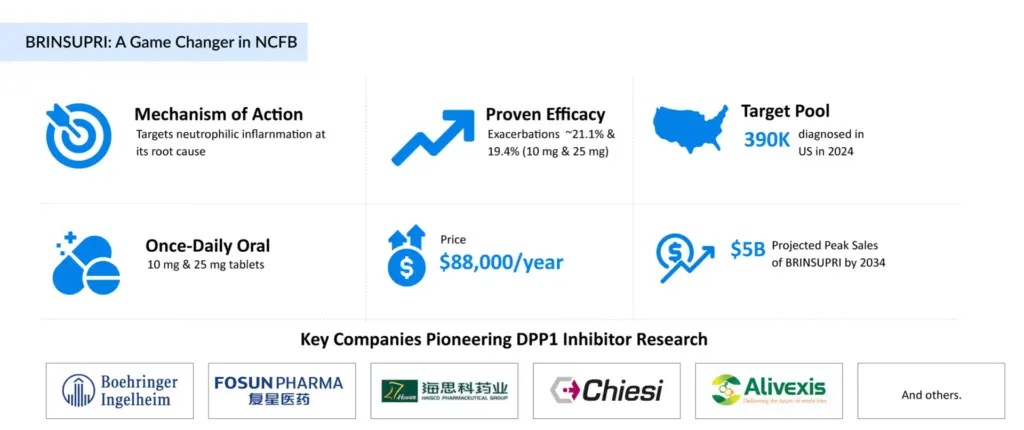Insmed’s BRINSUPRI, the First DPP1 Inhibitor: A New Era in NCFB Treatment
Aug 25, 2025
Insmed’s BRINSUPRI (brensocatib) has achieved a significant regulatory milestone, becoming the first FDA-approved therapy for non-cystic fibrosis bronchiectasis (NCFB) as well as the first approved DPP1 inhibitor. As the only NCFB treatment, this marks not just a scientific breakthrough but also a transformation in a market historically characterized by significant unmet needs. BRINSUPRI represents a novel class of medication that directly targets neutrophilic inflammation and the underlying causes of bronchiectasis exacerbations, providing a new therapeutic approach for patients.
In the US, approximately 390,000 individuals were diagnosed with NCFB in 2024, with global prevalence believed to be much higher. This is expected to rise to over 470,000 by 2034. BRINSUPRI is approved for adults and adolescents aged 12 and older.
The approval of BRINSUPRI is supported by findings from the Phase III ASPEN and Phase II WILLOW studies, both published in the New England Journal of Medicine. In the ASPEN trial, patients treated with BRINSUPRI 10 mg or 25 mg experienced reductions in the annual rate of exacerbations by 21.1% and 19.4%, respectively, compared with placebo.
Downloads
Click Here To Get the Article in PDF
Both doses also achieved several secondary endpoints related to exacerbations, including significantly delaying the time to first exacerbation and increasing the proportion of patients who remained exacerbation-free during treatment. Patients receiving the 25 mg dose showed a statistically significant slower decline in lung function, measured by bronchodilator-adjusted forced expiratory volume in one second (FEV₁), at week 52.
Safety was assessed in both studies, with the most common adverse reactions (≥2%) in ASPEN including upper respiratory tract infection, headache, rash, dry skin, hyperkeratosis, and hypertension. In WILLOW, the safety profile for adults with NCFB was generally similar, though there was a higher incidence of gingival and periodontal adverse events.
As the first DPP1 inhibitor in respiratory care, BRINSUPRI has a differentiated mechanism and first-mover advantage, positioning it as a potential standard of care for NCFB.
“The FDA’s approval of the first-ever therapy for non-cystic fibrosis bronchiectasis marks a historic moment for both patients and Insmed,” said Martina Flammer, M.D., MBA, Chief Medical Officer of Insmed. “By prioritizing patients in all that we do, we have introduced a first-in-class treatment for a condition that previously had no approved therapies. This represents a remarkable advancement in medicine. We are profoundly grateful to the patients, healthcare providers, and advocates who helped make this achievement possible – and this is just the start of what we can achieve together for this community.”

Given its unique position in the market, Insmed may commercialize BRINSUPRI independently rather than partner with a larger pharmaceutical company. Preparations for the product launch began before regulatory approval. Recently, Insmed raised around $750 million by offering approximately 7.81 million shares at $96 each, funds intended to support pre-launch and commercial activities. Following FDA approval, Insmed’s stock rose about 15%, with the largest single-day gain of 8% on the day of approval.
Insmed already holds a strong position in respiratory care with ARIKAYCE for MAC lung disease and now BRINSUPRI. EU and UK filings are underway. The company is expanding BRINSUPRI’s potential indications to include chronic rhinosinusitis without nasal polyps (CRSsNP) and hidradenitis suppurativa, both in mid-stage clinical development. BRINSUPRI’s market potential is significant. DelveInsight estimates peak sales could reach ~USD 3 billion in the 7MM by 2034, while the NCFB market overall is projected to exceed USD 5 billion by 2034.
BRINSUPRI is currently available by prescription in the US via a specialty pharmacy network, with an annual price of $88,000 before discounts. Submissions to the EMA and MHRA are in progress, with launches expected in 2026, reflecting a strong global commercialization strategy. The combination of early regulatory momentum and first-to-market status is likely to drive rapid adoption and significant revenue growth, establishing BRINSUPRI as a multi-billion-dollar franchise in the coming years. The absence of competing approved therapies reduces pricing pressures, supporting high returns.
Following BRINSUPRI approval, competition is emerging as companies like Boehringer Ingelheim (Verducatib), Fosun Pharma/Expedition Therapeutics (XH-S004), Haisco/Chiesi (HSK31858), and Melodia/Alivexis (MDI-0151) advance DPP1 inhibitors targeting NCFB.
Verducatib (BI 1291583) is an innovative inhibitor of dipeptidyl peptidase 1 (DPP1) and cathepsin C (CatC) that has the potential to enhance symptoms and overall quality of life in patients with bronchiectasis. By inhibiting DPP1, verducatib may reduce neutrophilic inflammation, a central factor in bronchiectasis development. This mechanism could help prevent airway damage, improve pathogen clearance, normalize mucus composition, and limit abnormal lung inflammation.
Boehringer Ingelheim is currently evaluating the efficacy, safety, and tolerability of verducatib versus placebo in individuals with bronchiectasis, regardless of underlying causes, through AIRTIVITY [NCT06872892], a Phase III, multicenter, multinational, prospective, randomized, double-blind, placebo-controlled study. The treatment duration ranges from one year to 18 months, with the primary endpoint being the annualized rate of pulmonary exacerbations up to week 76.
In addition to DPP1 inhibitors like BRINSUPRI, which have shown promise in treating NCFB by targeting neutrophilic inflammation, research is exploring other classes of inhibitors, including cell membrane modulators (CMS I-neb; Zambon), immunomodulators (ARINA-1; Renovion), and others, to address this condition.
CMS I-neb represents a potential first-in-class inhaled therapy for adults with non-cystic fibrosis bronchiectasis (NCFB) infected with Pseudomonas aeruginosa. Utilizing colistimethate sodium, it targets aerobic Gram-negative pathogens, including drug-resistant strains, by disrupting bacterial cell membranes to reduce and prevent pulmonary exacerbations. The therapy has received Breakthrough Therapy, Qualified Infectious Disease Product, and Fast Track designations from the US FDA, highlighting its potential to address a significant unmet need in this patient population.
In the PROMIS-I trial, CMS I-neb demonstrated a significant reduction in annual pulmonary exacerbation rates among NCFB patients. While PROMIS-II was terminated early due to the COVID-19 pandemic and lack of equipoise following PROMIS-I’s positive outcomes, a sub-analysis of pre-pandemic data confirmed results consistent with PROMIS-I. Zambon now plans to collaborate closely with regulatory authorities to accelerate CMS I-neb’s market approval. The Phase III PROMIS-I and PROMIS-II findings were published in The Lancet Respiratory Medicine in September 2024 and presented at the 6th World Bronchiectasis Conference.
ARINA-1 (RVN-301), under development by Renovion, is an innovative at-home nebulized therapy aimed at improving lung health by clearing mucus, reducing inflammation, and inhibiting bacterial growth. In April 2024, Renovion announced positive topline results from the Phase II CLIMB study of ARINA-1 in NCFB, supporting further development. The company intends to conduct deeper data analyses, engage with regulatory agencies, and progress ARINA-1 into a Phase III program.
The anticipated launch of these emerging NCFB therapies are poised to transform the NCFB market landscape in the coming years. As these cutting-edge NCFB therapies continue to mature and gain regulatory approval, they are expected to reshape the NCFB market landscape, offering new standards of care and unlocking opportunities for medical innovation and economic growth.
Key opinion leaders surveyed by DelveInsight view BRINSUPRI as a transformative therapy for NCFB, addressing a critical unmet need with a novel mechanism that targets neutrophilic inflammation. Clinical data demonstrating reduced exacerbations, improved lung function, and broad patient eligibility further support adoption. With first-mover advantage and favorable labeling, BRINSUPRI is positioned to redefine NCFB treatment. Once considered a symptomatic niche, the NCFB market, valued at USD 1.5 billion in 2024 and historically bronchodilator-driven, is shifting toward mechanism-based therapies, unlocking significant growth opportunities through targeted treatment, earlier intervention, and improved clinical outcomes.

Downloads
Article in PDF



